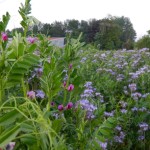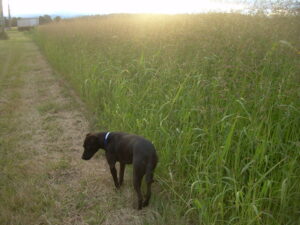The use of cover crops is an important part of our operation. We also harvest some seed for sale. Some of the main ones we currently sell are:
Currently available seed
To place an order or for more info:
Contact Alana: (541)905-2111 or email: alana.kenagyfamilyfarm@gmail.com
Cuttings available of:
- Snowberry – Symphoricarpos albus
- Spirea – Spiraea douglasii
Native Perennials:
- Blue-eyed Grass – Sisyrinchium idahoense
- Blue Wild Rye – Elymus glaucus
- California Oatgrass – Danthonia californica
- Common Camas/Great Camas – Camassia quamash/ Camassia leichtlinii
- Fringecup – Tellima grandiflora
- Slender Cinquefoil – Potentilla gracilis
- Roemer’s Fescue – Festuca roemerii
- Self Heal – Prunella vulgaris
- Slender Hairgrass – Deschampsia elongate
- Wolly Sunflower/ Oregon Sunshine
- Annuals
- Sweet Alyssum – Lobularia maritima
- Farewell-to-spring – Clarkia amoena
- American Sloughgrass – Beckmannia syzigachne
- Cover Crop Seed:
- Golden Flax
- Common Vetch
- Cereal Rye
- Lacy Phacelia
- Saia Oats
- Buckwheat
- Sudan Grass
Common Vetch
A vigorous, viney, annual legume that produces sizable amounts of green matter, attracts beneficial insects and provides good coverage for weed suppression. It is also commonly used for forage and can be planted well as part of a mix with small grains or ryegrass. Can be seeded in spring or fall at rates between 40-60 lb/acre.
Phacelia

phacelia and vetch
A purple, nectar-rich flower with a long flowering period. It is a great attractant for bees and beneficial insects. As a cover-crop it is easy to manage, fast establishing, weed-suppressing, with a long and planting window through spring, summer and fall. Seeding rate is around 4 lb/acre.
Sudan Grass
A narrow-stemmed, warm-season bunch grass that can get up to 7ft tall if left unmowed. Originally from Sudan, generally dies off well over winter in the Northwest. It is great for increasing soil organic matter, cycling nutrients, and suppressing weeds. Deeply penetrating roots also loosen soil and reduce nematode and symphylan populations as they decompose. It requires warm soil to germinate and can be planted when these conditions are available in late spring through mid-summer. Cornell University recommends an seeding rate of 30 lb/acre for biomass and nematode control or a 50 lb/acre for weed control.

Sudan grass
